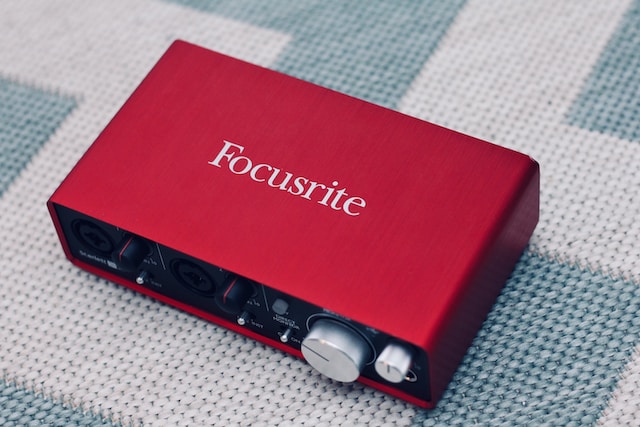An interface with numerous inputs is the obvious next step if you require something more powerful than a USB microphone to create music or make a podcast.
A straightforward recording solution, the Focusrite Scarlett 2i2 connects to your computer through USB-C and offers quarter-inch inputs that also serve as XLR inputs for microphones (also see, ‘USB Mic vs XLR‘).
It provides transparent recording paths and low-latency monitoring without needlessly complicating your setup.
The inability to quickly adjust the gain knob simultaneously is our main criticism.
Nevertheless, for anyone searching for a launching pad into the realm of expert recording, mixing, and monitoring, we heartily suggest the Scarlett 2i2.
Focusrite has a well-deserved reputation for producing some of the best audio interface and mic preamps of the highest caliber at pricing points to suit customers with all needs and financial constraints (also see, ‘Best Audio Interface For Podcast‘).
It may not come as a surprise that a newer, all the more compact range called Scarlett has been developed given the continued popularity and brand recognition of its Saffire family of interfaces.
Does it offer enough to catch the curiosity and satisfy the requirements of a fresh audio interface generation?
It has bold aesthetics, tank-like construction, and, of course, the legendary Focusrite preamps.
To find out if the Focusrite Scarlett 2i2 model is the right choice for you, keep reading this article.
We’ll go through the advantages and disadvantages so you can check if this great piece of kit will meet your needs.
Why Is An Audio Interface Necessary?
The two main purposes of audio interfaces, like Focusrite’s Scarlett 2i2, are connectivity and audio quality, both of which are essential for any engineer or producer.
When looking for audio interfaces, you’ll typically notice that the more costly the interface, the greater the level of connectivity (mainly, the amount of inputs and outputs) and sound quality (clean and more transparent) you may expect.
A USB audio interface is the most cost-effective and simplest way to get started in music production.
USB audio interfaces are versatile and relatively affordable, yet boast a good range of features such as phantom power for condenser microphones, MIDI ports for connecting synthesizers or drum machines, and multiple channel recording capabilities.
Since it typically serves as the conduit for all of the studio’s equipment, an interface can be considered the hub of most contemporary recording studios.
Though why? What is the goal? And how does this inform your decision over whether to purchase the Scarlett 2i2?
Audio Quality

You will undoubtedly obtain a recording of low quality if you plug your microphone directly into the USB C port on your computer.
Your computer and an audio interface are connected, and the audio handling for your music composition is handled by the audio interface.
You no longer rely on your computer’s sound card as a result. As an alternative, you have specialized audio processing for music making – or any other type of audio production.
This will enable you to produce audio that is of a higher caliber, particularly in terms of clarity and accuracy.
In order to deliver a colorless and transparent signal, interfaces are more advanced than a standard sound card.
Connectivity
It’s also important to note that the basic sound card on your PC lacks the outputs and inputs required for actual music production.
The majority of standard sound cards will just offer one straightforward 1/8″ microphone input, which is intended for basic PC tasks like voice communication and programs like Skype.
Your next step in development is to get a good studio mic and an interface to attach it to, such as the Scarlett 2i2.
The necessary outputs and inputs for mics are provided via an audio interface.
Since even a little delay with your stock sound card can ruin your recording performance, audio interfaces like the 2i2 also help minimize latency.
Focusrite Scarlett 2i2 Main Pros And Cons
PROS
- Clear audio recordings and great sound quality for any XLR microphone and quarter-inch inputs
- Low-latency observation
- Simple to assemble and use
CONS
- Gain settings for dual inputs cannot be perfectly matched
- The body is lightweight and can be pulled easily by cables

Overview Of The Focusrite Scarlett 2i2 Build
The Scarlett 2i2 has a black front plate and a distinctive red shell.
The input and control knobs, including the two quarter-inch/XLR inputs with corresponding gain knobs, are located on the front of the device.
These inputs can be used for microphones or as instrument inputs including basses, guitars, and keyboards.
Be aware that XLR gear, but not XLR microphones, are compatible with the combo inputs. For example, if you connect an effects processor’s XLR outputs, the signal will probably be distorted.
The inputs have two Inst and Air buttons below these knobs. Toggling between both the XLR and quarter-inch inputs is done by pressing the Instrument button.
Pressing the Air button will highlight higher frequencies.
Towards the right of these inputs is a button providing 48-volt phantom power for microphones that need it, and a Direct Monitor control below it toggles between three monitoring settings.
To listen to your audio through your software’s output, switch it on the Off position.
Otherwise, you can directly listen in either Mono or Stereo mode from the inputs, which will avoid any latency problems that could occur when you monitor through your computer.
A sizable knob located at the right end of the front plate controls the speaker monitor volume, and a smaller knob in the upper right-hand corner regulates the headphone volume.
Right behind the knob is a sizable quarter-inch headphone jack.
The USB-C connector is located on the back panel and is used to connect the audio interface to your computer using the supplied USB cable.
This connection powers the device and sends audio to your PC.
For mic or line-in inputs, these left and right line outputs feature a frequency spectrum of 20Hz to 20kHz, and the converter runs at 24 bits and up to 192kHz sampling rate.
Additionally, the back panel has a Kensington lock slot, allowing you to attach the box to a number of things (not included).
When capturing a pair of mics or an instrument, it would be considerably simpler to balance the inputs if the gain dials had detents.
There is only one mark on the dials to show which way they are pointed; otherwise, you must synchronize them by sound and sight.
We would rather have clearly defined knob locations or a push button that connects the two knobs such that turning one changes the gain for the other.
The 1.1 lb Scarlett 2i2 feels sturdy enough, but any of the four cords that are attached to it—two in the front, two in the rear, a USB connection to connect it to a computer, as well as a pair of headphones—can pull or tug at the box.
Even if you use stronger or braided cables, the rubber feet can’t quite provide enough traction to hold the box in place. However, the box is portable due to its lightweight construction.

Focusrite Scarlett 2i2 Setup And Software Support
The iPad Pro and computers that run at minimum Windows 7 and macOS 10.11 are both compatible with the Scarlett 2i2.
The package comes with some helpful add-ons, such as a collection of plug-ins and a few lightweight recording software versions.
For instance, it includes Pro Tools First – which is a limited 16-track version of Pro Tools.
Cubasis 2, Auria Pro, FL Studio, Garageband, Ampify Blocs Wave, Ampify Launchpad, and a host of other programs and recording tools are supported by the Scarlett 2i2.
Focusrite Scarlett 2i2 Recording Quality

The Scarlett 2i2 makes it simple to record vocals, and the signal is transparent. The Scarlett 2i2 is capable of crisp, latency-free monitoring and generating good recordings.
The clarity of your recordings largely depends on your mic and recording style.
Setting levels is also rather easy. Whenever the input signal is optimal, the concentric LED rings around the gain knobs flash green.
Whenever the input signal is inside 6dB of clipping, they glow amber, and when it clips, they glow red.
(Again, though, we would prefer to be able to connect the two dials so that it would be simpler to balance their levels.)
Using the quarter-inch inputs, there are no issues immediately recording instruments. bass guitars, effects pedals, and analogue synths all have clear, transparent tones.
Although it will work with any microphone sound source, the Air mode is perfect for recording vocals and guitar music.
It basically opens up a range of higher-frequency EQ that brings out some better qualities in vocal and guitar work.
Although models that already sound sharp may not require or profit from this additional emphasis, this mode can add extra highs to a darker mic, such as a ribbon mic.
The Focusrite Scarlett 2i2 is easy to use and won’t force you to begin debugging in the midst of a lengthy session or a creative explosion.
Final Thoughts
Overall, Scarlett is everything you’d come to expect from Focusrite: a wonderful, well-designed interface with a tonne of flexibility packed into a little package.
Although the absence of I/O may be a deal-breaker for some, this interface is worth selling by the truckload at such a low cost.
The Scarlett 2i2 is a great option if your recording requirements are greater than a single-track USB microphone can handle but you don’t want a full-blown console setup.
It is inexpensive, offers a dependable audio experience, and facilitates the recording, mixing, and monitoring of live audio.
The gain knobs might have used a little different control arrangement, but that is a small quibble. For enhancing recordings, the Focusrite Scarlett 2i2 is essentially a necessity.





